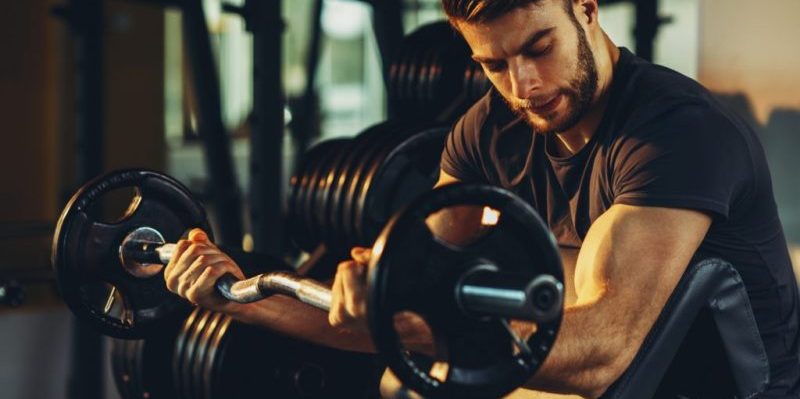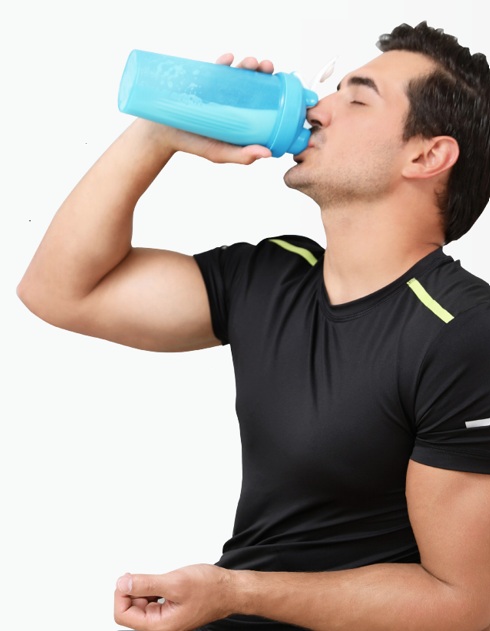
Think about the following questions.
1. What dietary supplements are popular in your country?
2. What are the benefits of using these products?
3. Do you believe you need dietary supplements?
VOCABULARY PREVIEW
Match each New Academic Word List(NAWL) word with the correct definition.
- maximize _____
- effectiveness _____
- metabolism _____
- dose _____
- illusion _____
- abdominal _____
- a. the processes by which the body uses nutrients to grow, heal, and make energy
- b. a measured amount of a medicine
- c. of or relating to the stomach
- d. the degree to which something can produce a desired result
- e. a false appearance
- f. to raise to the highest degree possible
CREATINE'S PLACE IN SPORTS AND FITNESS

Amid scandals involving sports stars using steroids and other illicit1 performance - enhancing drugs, a safe, natural alternative to such drugs is the holy grail2 for athletes who want an edge. Since its appearance on the market in the 1990s, creatine has been welcomed as a valuable fitness tool, if not the holy grail. Reports on its effectiveness have varied considerably, but the overall consensus is that it does have some effect, and most importantly, it's safe. As with most relatively new products, however, that second part continues to be questioned.
Creatine is an amino acid3 produced in the body, and it is also present in small amounts in meat and fish. According to the Food and Drug Administration (FDA), a healthy person requires only two grams of creatine per day, half of which is produced in the body by the liver, kidneys, and pancreas. Among other roles, creatine helps cells utilize energy. Increasing creatine levels has been shown to improve the body's energy use, especially during short but intense bursts of strenuous4 exercise. This discovery led to the development of high-dose creatine supplements (up to twenty grams daily) as a performance enhancer and workout aid.
Creatine supplements are designed to enhance athletic performance by making more energy available to muscles during exercise. It can be effective for increasing short-term muscular stress endurance in contact sports like football and, especially, in weight training. In addition to facilitating cell metabolism, it draws water into muscle cells, which can help the production of muscle fiber. Creatine was first introduced to Olympic athletes to maximize muscle energy output. It has since enjoyed wide use among professional and amateur athletes.
But the supplement attracted criticism shortly after its introduction. Early studies questioned creatine's effects on endurance. The gains were only observed in bursts of activity of thirty seconds or less, and these findings curbed5 the enthusiasm of informed athletes hoping to increase their energy throughout long periods of exertion6, as are typical in most sports. Nonetheless, the effect remained relevant for certain sports, such as powerlifting. And studies confirmed that extra repetitions in workouts translated into greater muscle mass gains-provided those taking the supplements worked out regularly and ate an otherwise balanced diet.
Another cause for concern has been water retention. Athletes "loading" creatine at high doses tend to take on extra water weight-as much as five pounds' worth in the first week. But the retention occurs inside the muscle cells themselves, so rather than the bloating normally associated with water retention, creatine retention actually just makes the muscles larger-without any added muscle mass or strength. This effect has been found to be neutral at worst, and some research suggests it has a positive effect on motivation. Creatine's muscle-pumping effect can be a placebo7 of sorts, which provides an illusion of success that motivates athletes to work harder. Eventually, this translates into increases in muscle mass as well-but as a result of the extra exercise, not the water.
The debate on creatine supplement safety, however, has gone back and forth since the beginning. Mild side effects like abdominal discomfort and diarrhea8 are well established but not major concerns. Some early studies caused concern about links to kidney problems. Continued study, however, revealed no direct link between creatine and any known kidney disorder. Kidney disorders that involve tissue swelling, however, can be made worse by high doses of creatine, which increases tissue swelling even more. In simple terms, creatine won't cause kidney problems, but it can worsen existing ones. Early concerns about liver damage were not borne out by subsequent research. As with its effect on the kidneys, creatine won't cause liver problems, but it can swell liver tissue. A 2015 study by the Harvard School of Public Health linked creatine use to testicular9 cancer in young adults, finding that those who used the supplement were more likely to be diagnosed with the cancer. However, no additional studies have confirmed this finding, and a 2019 study actually found that creatine can help fight cancer.
Several public-health institutions, like the National Institutes of Health, conclude creatine is possibly effective for certain groups (excluding the elderly and already highly trained athletes). But they advise against creatine use for those under the age of eighteen, in part because its effects on the endocrine-or hormonal10—system are not yet well understood.
New Academic Word List
- illicit 1 : adj. not allowed
- holy grail 2 : n. something sought after for its great significance
- amino acid 3 : n. one of the acids that form proteins in living things
- strenuous4 : adj. requiring great energy and effort
- curb 5 : v. to reduce
- exertion 6 : n. physical or mental effort
- placebo 7 : n. a substance given to a patient that has no physical effect but may have a psychological one
- diarrhea 8 : n. a condition in which a person passes waste often and in liquid rather than solid form
- testicular 9 : adj. of or relating to the testes, the male reproductive glands that produce sperm
- hormonal10 : adj. of or relating to the hormones, substances produced in the body that influence its growth and development
READING COMPREHENSION
A ‣ Mark each statement as true (T) or false (F) according to the reading.
- Creatine is an artificial chemical.
- True
- False
- Creatine aids muscle growth by drawing water into cells.
- True
- False
- Creatine may be effective for short periods of exertion.
- True
- False
- The side effects of creatine are generally not severe.
- True
- False
- Several studies have suggested that creatine causes cancer.
- True
- False
B ‣ Choose the best answer according to the reading.
- What is the main idea of the reading?
- a. Creatine can lead to cancer, and its use is a growing public-health threat.
- b. Creatine has been unfairly called unsafe in spite of scientific evidence.
- c. Creatine has some benefits, but its safety remains in doubt.
- d. Creatine has been promoted with exaggerated claims.
- Which of the following would supply creatine naturally?
- a. Steak
- b. Steroids
- c. Tomato juice
- d. Baked potatoes
- We can guess from paragraph 6 that creatine's possible link to cancer _____.
- a. shows that it should be banned
- b. is inconsequential
- c. proves that it is unsafe
- d. warrants further study
- The word they in paragraph 7 refers to _____.
- a. athletes
- b. the elderly
- c. institutions
- d. group homes
C ‣ Look for the answers in the reading and write them on the lines.
- How can creatine enhance a workout?
_____ - What does research show about creatine's effect on the kidneys and liver?
_____
SUMMARY
Fill in the blanks with the phrases in the box.
- muscle fiber
- kidney problems
- metabolize energy
- testicular cancer
- periods of exertion
- water retention
|
How It Works
|
|
How Well It Works
|
|
How Safe It Is
|
VOCABULARY PRACTICE
Fill in the blanks with the words in the box. Change the form if necessary.
- abdominal
- dose
- effectiveness
- illusion
- maximize
- metabolism
- The recommended _____ of many medicines depends on the patient's age and weight.
- Magicians can't really make things disappear; it's just a(n) _____ .
- Recent studies have called the _____ of corporal punishment into question.
- Students are advised to get a good night's sleep to _____ their attention during exams.
- Hummingbirds have the fastest _____ found in any animal.
- People who suffer from _____ cramps may find temporary relief by lying on their backs.
SUPPLEMENTAL READING
Drug Testing

Random drug testing is used by professional sports associations to catch athletes who are illegally trying to enhance their performance. In 1995, the US Supreme Court ruled that it was also legal for high schools and middle schools to randomly test student athletes for drugs. In 2002, the Supreme Court ruled that random drug tests could also be given to any student participating in any school-related competitions.
In an online survey conducted by the National Federation of State High School Associations (NFHS) and other groups in 2003, it was determined that thirteen percent of the nation's high schools had a general drug-testing policy in effect. A 2016 study determined the rate had increased to thirty- eight percent. But according to the US Anti-Doping Agency, very few of these programs include testing for sports-related drugs. Meanwhile, a survey conducted by the Partnership for Drug-Free Kids determined that steroid use has been increasing at a steady rate of five to ten percent per year and that the use of human growth hormone (HGH) has risen from five to seven percent. In other words, performance-enhancing drug use is on the rise. But testing is not.
There are several reasons for the relatively low rate of implementation of drug-testing programs in US public schools. The American Civil Liberties Union (ACLU) and other groups have argued that the Supreme Court decisions are an invasion of privacy and a violation of the Fourth Amendment to the Constitution, which protects individuals from unreasonable searches. Additionally, drug-testing programs may be considered too expensive in schools with limited budgets.
Fill in the blanks with information from the reading.
- Drug testing in schools was ruled legal by the _____ .
- Thirty-eight percent of schools test for drugs, but few test for _____ .
- The ACLU says that drug testing for athletes violates the _____ to the Constitution, which bans unreasonable searches.

Leave a comment
Load more